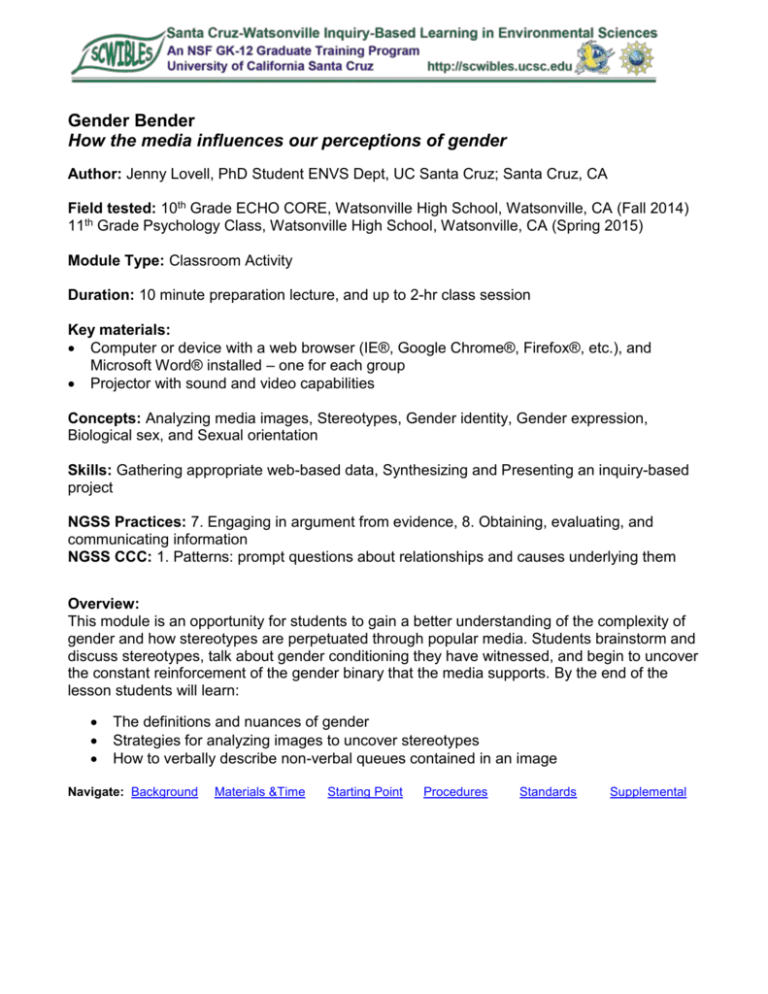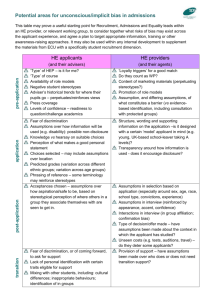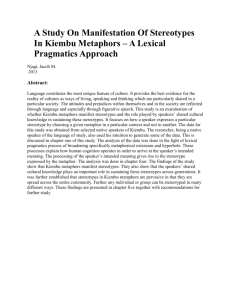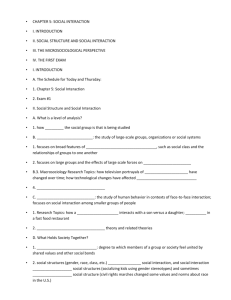
Gender Bender
How the media influences our perceptions of gender
Author: Jenny Lovell, PhD Student ENVS Dept, UC Santa Cruz; Santa Cruz, CA
Field tested: 10th Grade ECHO CORE, Watsonville High School, Watsonville, CA (Fall 2014)
11th Grade Psychology Class, Watsonville High School, Watsonville, CA (Spring 2015)
Module Type: Classroom Activity
Duration: 10 minute preparation lecture, and up to 2-hr class session
Key materials:
Computer or device with a web browser (IE®, Google Chrome®, Firefox®, etc.), and
Microsoft Word® installed – one for each group
Projector with sound and video capabilities
Concepts: Analyzing media images, Stereotypes, Gender identity, Gender expression,
Biological sex, and Sexual orientation
Skills: Gathering appropriate web-based data, Synthesizing and Presenting an inquiry-based
project
NGSS Practices: 7. Engaging in argument from evidence, 8. Obtaining, evaluating, and
communicating information
NGSS CCC: 1. Patterns: prompt questions about relationships and causes underlying them
Overview:
This module is an opportunity for students to gain a better understanding of the complexity of
gender and how stereotypes are perpetuated through popular media. Students brainstorm and
discuss stereotypes, talk about gender conditioning they have witnessed, and begin to uncover
the constant reinforcement of the gender binary that the media supports. By the end of the
lesson students will learn:
The definitions and nuances of gender
Strategies for analyzing images to uncover stereotypes
How to verbally describe non-verbal queues contained in an image
Navigate: Background
Materials &Time
Starting Point
Procedures
Standards
Supplemental
Gender Bender
Background for Teachers
Why this matters: Gender is a relevant and contentious topic that is constantly reinforced
through non-verbal queues in the media. LGBTQA (lesbian, gay, bisexual, transgender, queer,
and questioning) issues are hotly debated in schools, courts, and public media venues. While
most people think of gender as a simple binary (i.e. man or woman), gender is a complex and
delicate continuum that includes many aspects that are not often discussed.
Assumed background: Students must be comfortable conducting an oral presentation in front
of classmates. No other prior knowledge is necessary.
Scaffolding supplements:
1. Gender Lecture (Attached)
2. Gender Activity Worksheet (Attached)
3. TED Talk by Sam Killermann (https://www.youtube.com/watch?v=NRcPXtqdKjE#t=21)
Module Description
Materials:
• Computer or device with a web browser (IE®, Google Chrome®, Firefox®, etc.), and
Microsoft Word® installed – one for each group
• Projector with sound and video capabilities
Preparation:
1. Print or upload worksheets for the students to complete in class (Gender Activity)
2. Break class into groups of 2-3 maximum
3. Preview the Video (TED talk by Sam Killerman)
Timeline:
Introduction and “Do Now” box on Worksheet (5 minutes)
Gender Box exercise (15 minutes)
TED Talk Video: Sam Killermann (15 minutes)
Presentation and class media analysis (25 minutes)
a. Present PowerPoint and example images
b. Class breaks the examples down together
5. Groups break out and find their own images (30 minutes)
6. Group presentations (30 minutes)
1.
2.
3.
4.
Starting Point For Inquiry:
There are many stereotypes associated with being a “man” or a “woman.” This exercise is
designed to discuss those assumptions and analyze how they are reinforced in the media
every day. When we think of gender, we think of these two words: man and woman. However,
gender is much more complex than a simple binary.
The best way to break gender down into more complex and accurate parts is through three key
vocabulary words: gender identity (how you think about your own gender), gender expression
© 2014 SCWIBLES NSF GK-12 Program at UC Santa Cruz http://scwibles.ucs.edu
2
Gender Bender
(the way you express your gender identity though actions, dress, words, or behavior), and
biological sex (male and female sexual organs).
Now think about how stereotypes about “men” and “women” are reinforced, perpetuated, and
policed. From the minute a baby is born, they are dressed in masculine or feminine colors,
given gender-appropriate toys, and taught how to behave in a gender-specific manner. For
example, the phrase “boys will be boys” indicates that biological sex determines how young
men behave, rather than social conditioning. Girls wear pink, while boys wear blue.
Understanding the visual and verbal ways that these stereotypes are continued can help
students question their validity and break down false assumptions.
Detailed Procedure:
1. Introduction and “Do Now” box on Worksheet (5 minutes total)
a. Introduce the topic of gender and give the students a general outline of the day
(1 min)
b. Do Now: Think of a book, film, TV character that represents a “man” to you. Who
is it and why? Think of a book, film, TV character that represents a “woman” to
you. Who is it and why? (4 min)
2. Gender Box exercise (15 minutes total)
a. Draw two giant boxes on the board and introduce the key concept of a stereotype
b. Ask the students to brainstorm stereotypes about what is “Manly” (7 min)
c. Ask the students to brainstorm stereotypes about what is “Ladylike” (7 min)
3. TED Talk Video: Sam Killermann (15 minutes)
a. Killerman covers 4 main vocabulary points. Try to stop the video when he
reaches the conclusion of each explanation to reword the ideas for the students
because he talks very quickly.
4. Presentation and class media analysis (25 minutes)
a. Example images: Jane the Virgin, Arrow, and the cover of a Beyonce/Jayze
album
b. Class breaks the examples down together
5. Groups break out and find their own images (30 minutes total)
a. Go over the group project questions individually, allowing for students to ask
clarifying questions (5 min)
b. Break into groups (5 min)
c. Find an image and have the instructor approve appropriateness (5 min)
d. Group discussion of each of the worksheet questions (15 min) *Be sure that each
group member is ready to speak/discuss one or more questions
6. Group presentations (30 minutes)
Assessment Methods:
The culminating assessment is an oral and visual presentation. The students display the image
they choose to analyze, discussing the elements of the image that reinforce or depart from
gender stereotypes.
Possible pitfalls:
This is a sensitive subject for students. Students may identify outside the stereotypical gender
roles, or they may hold strong opinions about those who may not fit in. It is important before
beginning any of the exercises to emphasize respect for difference, non-violence, and creating
a “safe zone” within the classroom. In other words, students need to be able to discuss gender
© 2014 SCWIBLES NSF GK-12 Program at UC Santa Cruz http://scwibles.ucs.edu
3
Gender Bender
stereotypes openly. A good solution to this issue is to start the class by verbalizing the
assumption that all students are discussing stereotypes they have noted, observed, or
experienced; rather than stereotypes they agree with or believe. This gives a sense of
anonymity to each student’s contribution and allows an open discussion.
Glossary:
Gender Identity: the internal perception of an one’s gender, and how they label themselves,
based on how much they align or don’t align with what they understand their options for gender
to be. Common identity terms include man, woman, genderqueer...
Gender Expression: the external display of one’s gender, through a combination of dress,
demeanor, social behavior, and other factors, generally measured on scales of masculinity and
femininity.
Biological Sex: a medical term used to refer to the chromosomal, hormonal and anatomical
characteristics that are used to classify an individual as female or male or intersex. Often
abbreviated to simply “sex”.
Sexual Orientation: the type of sexual, romantic, physical, and/or spiritual attraction one feels
for others, often labeled based on the gender relationship between the person and the people
they are attracted to (often mistakenly referred to as sexual preference)
Media: film, television, music, newspapers, magazines, online sales
NGSS Standards Addressed
Science & Engineering Practices
7. Engaging in argument from evidence
8. Obtaining, evaluating, and communicating information
Cross Cutting Concepts
1. Patterns: prompt questions about relationships and causes underlying them
Guide to supplemental materials
Gender Activity (GenderActivity.docx)
A worksheet activity completed in class to supplement the lesson
Gender Presentation Images (GenderPresentationImages.pptx)
A PowerPoint presentation of images from popular media that instructurs can use to
demonstrate to students how popular images can be reinforce gender sterotypes in society.
© 2014 SCWIBLES NSF GK-12 Program at UC Santa Cruz http://scwibles.ucs.edu
4
Gender Bender
Graphics
Worksheets
Gender in the Media Activity Worksheet
Videos
Sam Killerman Ted Talk
Assessment Materials
N/A
© 2014 SCWIBLES NSF GK-12 Program at UC Santa Cruz http://scwibles.ucs.edu
5









